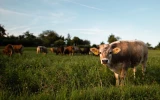What Is the Minimum Acreage for Farm Tax Benefits?
As a small-scale farmer, there are certain tax benefits available to you if you meet the minimum acreage requirement. Understanding the acreage requirement and the associated tax benefits is important for farmers looking to maximize their profits. This article will explain the minimum acreage required to receive farm tax benefits as well as the types of tax benefits available.
Generally, the minimum acreage for a farm to qualify for farm tax benefits is five acres, although it may be higher or lower in certain areas. The specific benefits available to a farm may be determined by the total acreage and vary depending on the jurisdiction and type of farm.
Knowing the minimum acreage for farm tax benefits can help you better understand the financial benefits of farming and help you maximize your tax savings.
Summary
- The minimum acreage for farm tax benefits varies depending on where you live as well as the type of agricultural activity you are engaging in.
- The type of activity you are engaging in may also impact the amount of acreage required, as certain types of farming activities may require more acreage to qualify for tax benefits.
- It is important to research the specific requirements in your state or locality that may require additional licenses or permits to qualify for farm tax benefits.

On this page:
Five Acres Is The Minimum Acreage for Farm Tax Benefits
To qualify for farm tax benefits, the farm must have at least five acres of land. This includes any combination of cropland, pastureland, woodlands, and/or other types of agricultural land.
The minimum acreage for a farm to qualify for farm tax benefits is five acres because farming is a labor-intensive activity and involves a significant investment of resources. Five acres are considered to be the minimum amount of land necessary to support a viable farming operation.
This acreage can provide enough land to grow and harvest a variety of crops, tend to livestock, and provide adequate space for the necessary farm equipment and structures. Additionally, this acreage is large enough to help ensure that the farm will be able to generate sufficient income to support itself and its operations.
The land must be used for agricultural purposes, such as raising crops, livestock, or other agricultural products, and must have been in agricultural use for at least two of the last five years. Additionally, the land must be owned and operated by the same individual or entity for at least two years before claiming the tax benefits.
How to Qualify for Farm Tax Benefits
To qualify for farm tax benefits, the taxpayer must demonstrate that they are actively involved in a farming business by meeting certain criteria. These criteria include:
Owning and operating a farm to qualify for farm tax benefits
The farm must be owned and operated by an individual or family, usually as a sole proprietorship, partnership, or family farm corporation. It must be in active use for the production of agricultural products for sale and have been in operation for at least three of the five years before the tax year.
The farm must be located in the United States, its territories or possessions, or any foreign country and must be operated to make a profit. It must be owned and operated by a person or persons who are actively engaged in the management, supervision, or control of the operation.
The farm must be operated following accepted agricultural practices. It must have an annual gross income of at least two times the cost of production.
Growing and/or cultivating agricultural products to qualify for farm tax benefits
The agricultural products must be grown with the intent of selling them as a commodity and must be grown on land that is owned or leased by the taxpayer. These products must be grown on land that is devoted to agricultural use, such as growing crops or raising livestock.
The taxpayer must:
- Be actively involved in the farming operations, such as planting, cultivating, harvesting, and marketing the crop
- Keep records of production, sales, expenses, and other activities related to farming operations
- Use a consistent method of accounting for the farming operations
Earning a substantial amount of income from farming activities to qualify for farm tax benefits
Earn a minimum of $1,000 in net income annually from farming activities. Purchase land, buildings, machinery, and equipment to be used in farming activities. Maintain detailed records of all expenses related to farming activities.
To verify this, the taxpayer must provide documentation that shows their involvement in the farming business. This may include receipts, invoices, and other documents that demonstrate their active involvement in the farming business.

How Much Are Farm Tax Benefits?
Farm tax benefits can include deductions for the cost of farm equipment, livestock, fuel expenses, repairs and maintenance, supplies, and other operating expenses. These deductions can range from $100 to $10,000, depending on the size of the operation.
Additionally, farmers may be eligible for a capital cost allowance, which can provide a tax deduction of up to 50% of the cost of eligible farm assets. Farmers may also be able to deduct the cost of hiring a farm manager or other hired help, as well as the cost of transportation for farm-related activities.
Finally, farmers may be able to receive a tax credit for up to $1,000 of their eligible farm income.
Advantages and Disadvantages of Farm Tax Benefits
Here are the advantages that the farmer or the taxpayer can get from having farm tax benefits:
-
Farm tax benefits can provide farmers with a tax break on items such as farm machinery, seed, fertilizer, chemicals, and other expenses related to running the farm.
-
A farmer may be able to deduct expenses related to the farm, such as land, buildings, and equipment, from their taxable income.
-
Farm tax benefits can also include deductions for capital improvements, such as the construction of a new barn or the purchase of new livestock.
-
Farmers may also be able to reduce their tax bill by taking advantage of special tax credits, such as energy credits for renewable energy sources or conservation credits for sustainable farming practices.
-
Farm tax benefits may also include deferring capital gains taxes on the sale of farm property.
-
In some cases, farmers may be able to take advantage of tax-free agricultural income, such as income earned from the sale of certain farm products.

Here are the disadvantages that the farmer or the taxpayer can get from having farm tax benefits:
-
Farm tax benefits can result in an unbalanced distribution of wealth, as large-scale corporate farms often take advantage of available tax breaks, resulting in the wealthy receiving more tax relief than small-scale farmers.
-
Farm tax benefits can result in an inequitable distribution of resources, as larger farmers may have access to more tax breaks than smaller farmers, potentially creating an unequal playing field.
-
Farm tax benefits can reduce the amount of tax revenue collected by the government, resulting in a loss of income for government agencies and services.
-
Farm tax benefits can cause a decrease in the amount of taxes paid by farmers, which can lead to an increased burden on other taxpayers.
-
Farm tax benefits can result in a decrease in the quality of the environment as large-scale farms may take advantage of the tax breaks to maximize their output, potentially leading to pollution, soil degradation, and other environmental issues.


